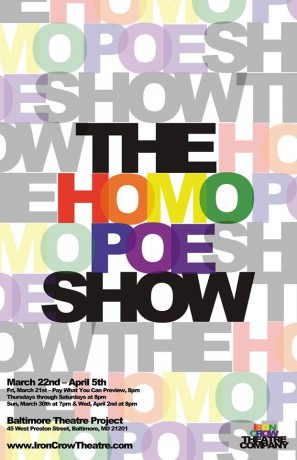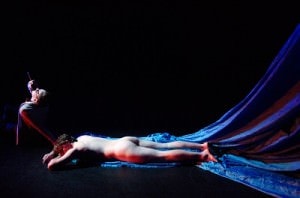Conceived as a new work by Artistic Director Steven J. Satta, where each of the seven installments has an individual director, Iron Crow Theatre Company’s The Homo Poe Show – a reinvention of Edgar Allen Poe’s dark and twisted works – is a conceptual stretch of the -To quote the raven, “Never before…” Well not exactly, but it can be said that never before have the likes of imagination, inviting the audience into the skewed perceptions and reinvented notions of the company’s core mission. Overall the show should be considered a work-in-progress with a great deal of potential that upon further workshopping sessions could be an intellectually provocative and aesthetically pleasing success. At present the show stands as seven loosely connected segments that have subtle sprinklings of Edgar Allen Poe misted throughout as their unifying bond.

I Dream of Poe
Choreographed and Performed by aerial artist Mara Neimanis, this introductory piece, while aesthetically stunning, feels completely superfluous to the show as a whole. The music that underscores the aerial composition has little if any relation to Poe in any obvious sense. Grasping at straws, one might say that the chaos of this piece is intended to represent the ever churning chaos present in Poe’s mind and thusly in his works, but this is a stretch at best. Neimanis’ aerial performance is exceptional; her body fully engaged, but the piece as a whole does not fit into the evening’s remaining performances.

Thomas
Written by Daniel Talbott and Directed by Steven J. Satta, this piece is one of the remaining six that does touch quite closely on Poe’s style of prose and his notes of obsession. Hovering over the theme of madness, this segment envelops the emotional flow of Poe’s work quite well. But Satta’s decision to include gratuitous, albeit tasteful and delicious, full body nudity detracts from the overall message of the piece. Without the enticing distraction the play would have been just as profound, if not more so.
Sound Designer Nick Hood really brings the tranquility of the seashore to this piece with his simple sounds of wave crashing on the sand mingled with the delicate cry of gulls; a fitting aural pleasure that augments the fluid prose of the Young Man (Nick Horan). Honing in on the dark emotional sensations of longing and grief, Horan’s delivery of this lengthy text is one of the closest links to Poe’s lovelorn poems in the entire production. Horan also engages in exceptionally intimate physical moments with Thomas (Jon Dallas) creating striking moments of visual intimacy.
The Trick
Written by Rich Espey and Directed by Ryan Clark, this performance segment focuses on a more direct link between Poe’s work and his use of repetition in his poetry. This is also the only piece where the aerial choreography does not feel completely out of place and gratuitous. Espey’s ability to craft a sharp and witty personality into the character of Time (Jenna Rossman) juxtaposes quite vivaciously against the obsessive tendencies of Billy (Sean Elias). Both performers are fully present in their quirky delivery of these two characters that are no stranger to Poe’s work; time and the man obsessed with defeating it. Espey’s work also includes blatant references to Poe’s stories, including The Cask of Amontillado, among others. Director Ryan Clark drives this piece with a constant pace, further echoing the sentiments of time’s infinite movement. Having the character of Time suspended from the aerial hoop is symbolic irony and fits the work well.
Super-Hot Raven
Written by Megan Gogerty, and Directed by Ryan Clark, this piece also focuses intently on Poe’s obsession, repetition and quite obviously is a play on his poem The Raven. The character’s are well constructed, both the Poet (Meggie Twible) and the Raven (Madeline Hicks) have distinctive voices and tones in which they speak. The chemistry created between Twible and Hicks’ characters is heated and genuine, not relying on devices or text to make it feel authentic. Both women embody extremely sensual body language, letting the more subtle undertones of sexuality in a potentially forbidden relationship bubble to the surface. Gogerty’s ability to craft a completed story in a short space is impressive. Giving both actors a great deal to work with in this short scene, this segment of the work could easily be fleshed out into a full-length one-act, fully encompassing many of the keynotes that define Edgar Allen Poe’s works.
Points of Grief
As the only work not conceived solely for The Homo Poe Show, once again the piece, while visually stunning, feels out of place and superfluous. Choreographed and Performed by Mara Neimanis, this aerial feat, performed on a metal sculpture (created by Tim Scofield) of an arrow has the right emotion to be a work of Poe re-imagined, but otherwise feels disconnected. There is a striking moment in the choreography where Neimanis is laid upon the floor with the arrow swinging over her and this is reminiscent of The Pit and the Pendulum. Outside of that moment the piece feels a lot like filler.
Do You Mark Me Well?
Another curious piece, Choreographed by Tony Byrd with Original Music by John Somers, this segment is entirely without words and done as an interpretive dance piece. The piece is aesthetically stunning; a truly sensual and emotionally evocative piece to watch, but again the overall relation to not just Poe but to the performance as a whole feels lacking. That said, the emotions that are portrayed by dancers Tony Byrd and Alex Weinberg are remarkable. The use of shadow play, compliments of Lighting Designers Alec Lawson and Kendra Richard, creates a surreal layer of existence around the performance. The constant give and take, back and forth of the dance itself is mesmerizing. There is a magnetism with which Byrd and Weinberg relate to each other’s bodies; falling in on themselves, wrapping around each other and overlapping each other’s movements. Their physicality in this performance piece is a stunning visual representation of co-dependency and obsession.
Grieving and Sequins
Written and Directed by Steven J. Satta, this piece is the best and most fully articulated of the seven in regards to vision and mission statement. While the references to Poe are not as strong as they are in Super-Hot Raven and The Trick, they are clear. The story moves fluidly, the grief and emotions are felt thoroughly and it is acted with concise integrity. The minor drawback of this piece is again the superfluous use of the aerial device; scenes played out upon which that could have just as simply been blocked on the floor and focused the audience on the emotion of the relationships and text in that scene rather than distracting them with the bodies in motion in the air.
Playing Rory, Nick Horan gives a startlingly raw emotional portrayal of grief in its darkest hour; a true sensation to behold and experience. Interacting with both The Figure (Weinberg) and Richard (Elias) Horan’s approach to the piece comes from a place of genuine understanding, each moment lived to its fulfillment before gliding into the next. The piece is intriguing even if the seven segments are disjointed and the title is a bit misleading; worth investigating before its brief run concludes.
Running Time: Approximately 2 hours and 15 minutes, with one intermission.
The Homo Poe Show plays through April 5, 2014 at Iron Crow Theatre Company at The Baltimore Theatre Project— 45 West Preston Street, in Baltimore, MD. For tickets call the box office at (410) 752-8558, or purchase them online.





Gratuitous is defined by the OED to mean “uncalled-for; unjustifiable”. So how can the nudity also be tasteful, defined as “Having or showing good taste; aesthetic”.
As someone who saw the show, I think you may have missed the fact that the memory of Thomas was what we saw. The nudity therefore was how Thomas is remembered by the Young Man, making it completely justifiable. Also, it might have been the choice of the playwright.
If I recall correctly, the character often says “Thomas was…” or “I remember…”
I wonder if this were Equus, would you have said it was gratuitous?